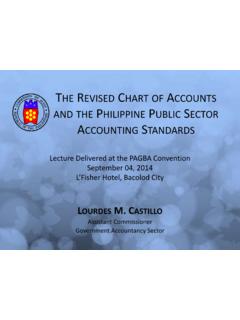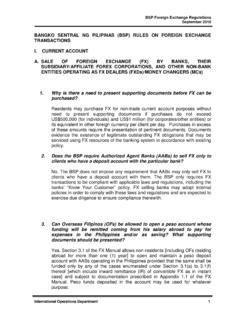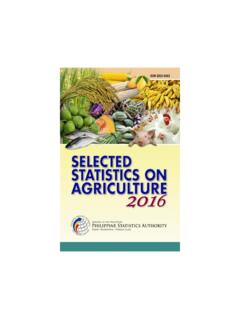Transcription of 2016-2022 Philippine Cacao Roadmap
1 Preface In the recent years, the Cacao Industry has been gaining recognition in the domestic and export markets as the supply and demand gap of cocoa beans is increasing. The world demand for Cacao has nearly tripled since 1970 growing at an annual rate of 3% with China and India growing at One of the primary drivers of this increase is the growing middle class, increasing discretionary household income in developing countries, new and innovative uses of cocoa in the food, cosmetics and pharmaceutical industries, and the positioning of Cacao as health food.
2 With the Philippines' location conducive for Cacao production and accessible to domestic and foreign trade, heightened the interest of local farmers and exporters to push for a more dynamic and competitive Cacao industry that can compete with other major Cacao -growing nations. But why Cacao ? This is the primary question being asked by those who have reservations as to the real potentials of the Cacao industry. Basically, Cacao may significantly contribute to poverty alleviation and inclusive growth through livelihood and job generation.
3 This is because Cacao production only requires small monetary investment or start-up capital. This explains why 90% of the growers are of small farm holdings. The suitability of Cacao as an intercrop for coconut and banana, the two-week harvest interval, and the early gestation period of 18 months are some of the most valued advantages of this high value crop. The early return of investments and high profitability of the product also ensure good income augmentation potentials. Above all, the industry is market-driven considering that Cacao has no product substitute.
4 Its diversified usage as food and non-food warrants a sustainable marketing opportunity. The Philippines is a net importer of Cacao on the other hand, global supply shortfall is expected to be at 1. million metric tons (MMT) by 2020. Given these opportunities, players across the Industry Value Chain must boost their productivity and competitiveness in order to have a significant impact in the overall economic development of the country. Thus, through the series of consultations with the private and public sectors, this 2016-2022 Philippine Cacao Industry Roadmap , anchored on the Value Chain Approach and aligned with the 2022 Cacao Challenge (specifically to produce 100,000 MT of dried fermented beans by 2022), is being crafted to provide a harmonized direction and strategies that will serve as guide in the development and strengthening of the industry.
5 The Roadmap hopes to establish a sustainable and competitive Cacao industry, that is environmentally sound, economically viable and socially desirable. As such, it is envisioned to spur development through livelihood creation, job generation, and income augmentation thereby contributing to poverty alleviation, inclusive growth, and peace and order attainment particularly in the rural areas. A Philippine National Cacao Industry Council ( Philippine Cacao ) will also be created to spearhead the development of the industry.
6 This will be a private sector led council composed of public and private sector representatives. To provide co-leadership, the Department of Agriculture will co-chair the Council. i Table of Contents Preface ---------------------------------------- ---------------------------------------- ------------------- i I. State of the Industry a. Product ---------------------------------------- ---------------------------------------- ----------- 1. b. Production ---------------------------------------- ---------------------------------------- ------- 2.
7 C. Market Situation, Trends and Prospects ---------------------------------------- --------- 4. d. Financial and Profitability Analysis ---------------------------------------- ---------------- 11. e. Government Support ---------------------------------------- ---------------------------------- 13. f. Infrastructure Support and Logistics ---------------------------------------- ------------ 13. g. Research and Development ---------------------------------------- ----------------------- 15. h. Human Resource Development ---------------------------------------- ------------------ 16.
8 II. Cacao Industry Value Chain a. Value Chain Analysis ---------------------------------------- ------------------------------------ 16. b. Industry Constraints and Opportunities ---------------------------------------- ------------- 18. III. Road Map a. Vision, Mission, Goals and Objectives ---------------------------------------- ---------- 20. b. Bottomlines and Regional Commitments ---------------------------------------- ------ 21. c. Development Directions and Upscaling Strategies --------------------------------- 22.
9 D. Cacao Industry Action Plan ---------------------------------------- ------------------------ 22. e. Industry Cluster Governance Framework ---------------------------------------- ------ 24. f. Monitoring and Evaluation ---------------------------------------- ------------------------- 26. IV. Philippine National Cacao Industry Directory ---------------------------------------- ---------- 27. V. References ---------------------------------------- ---------------------------------------- -------------- 28.
10 VI. List of Acronyms ---------------------------------------- ---------------------------------------- ------- 29. ii I. State of the Industry a. Product Theobroma Cacao , the scientific name of Cacao , literally translates as food of the gods in Greek. The name Theobroma Cacao was first given to the cocoa tree by Carolus Linnaeus the Father of Modern Day Taxonomic Plant Classification. Cacao is the Mayan root word to describe the tree and its product. It is grown mainly for its seeds known as the cocoa beans which are used to make cocoa mass, cocoa powder and chocolate.






